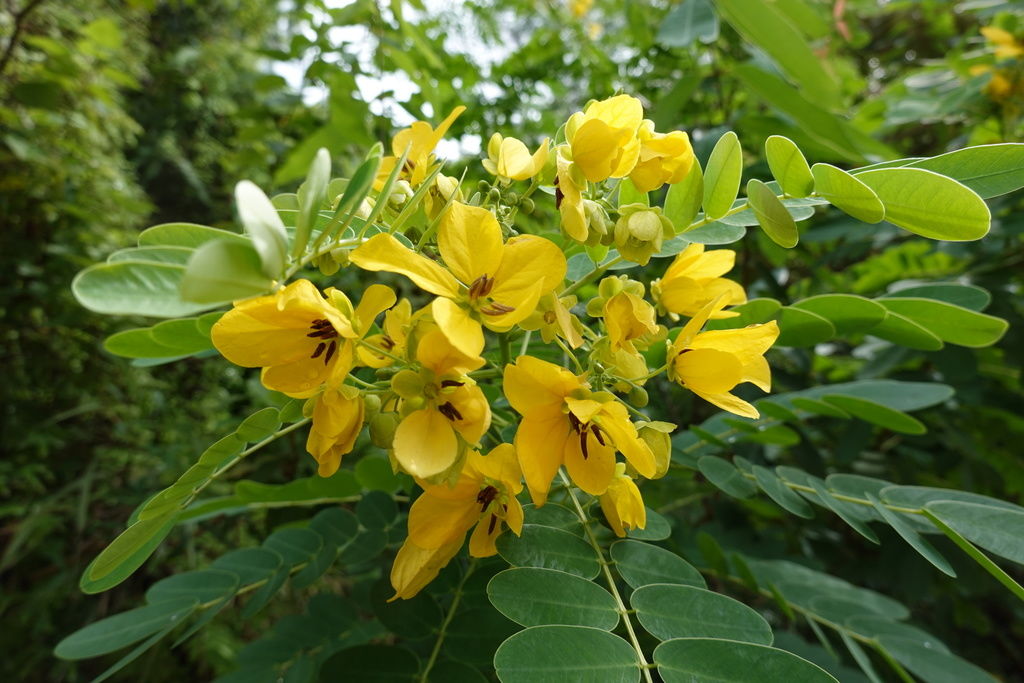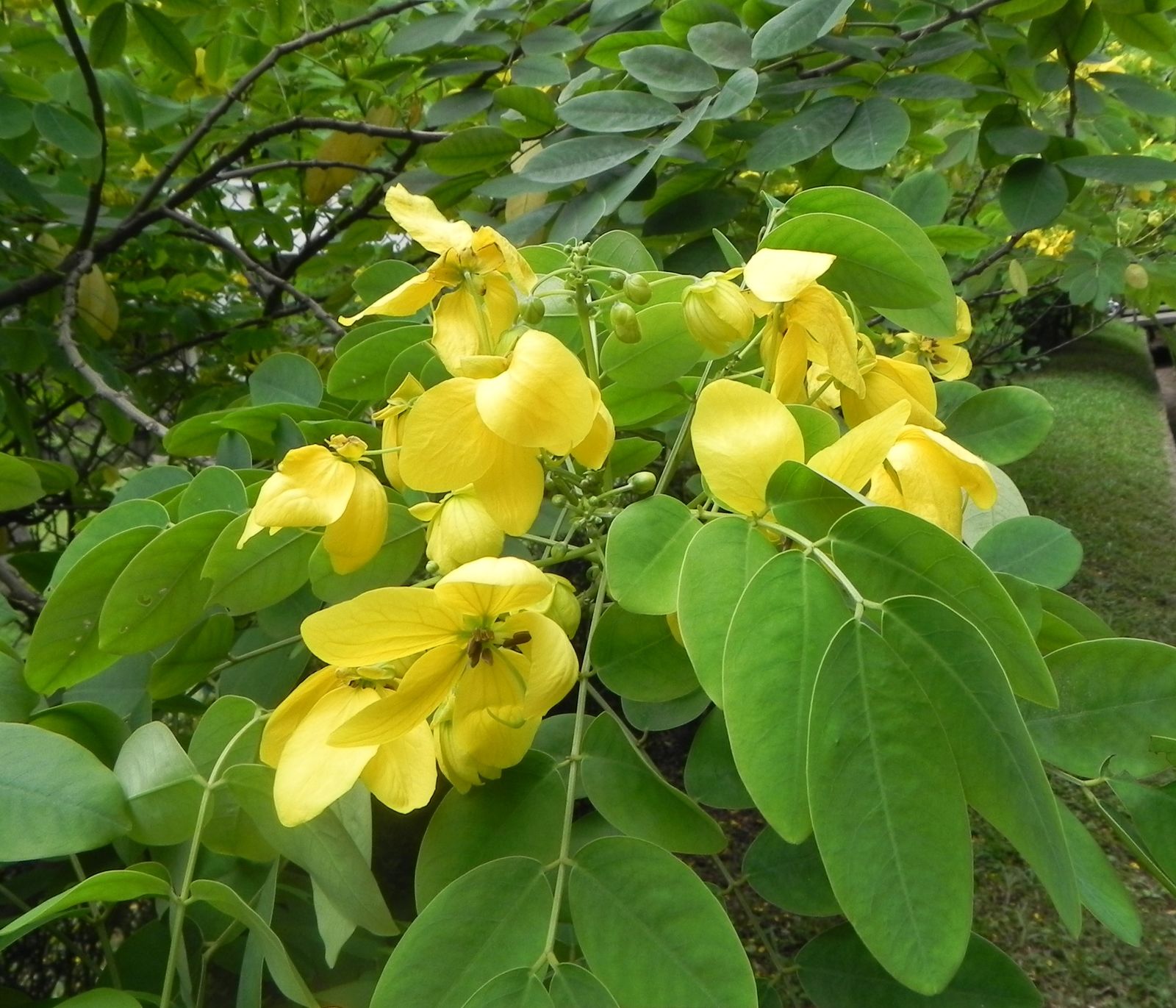Candlestick Senna
senna surattensis
Also known as: ["Candlestick Senna","Golden Candle"]
Overview
A fast-growing, evergreen shrub or small tree with bright yellow, candle-like flower spikes that bloom year-round in tropical climates.
Benefits & Perks
["long-flowering","fast growing","wildlife attractant (bees, butterflies, birds)","drought tolerant"]
Botanical Classification
| Phylum: | Magnoliophyta |
| Class: | Magnoliopsida |
| Order: | Fabales |
| Family: | Fabaceae |
| Genus: | Senna |
| Botanical Name: | Senna surattensis |
Plant Characteristics
Basic Information
- Category: Flowers
- Suitable Location: outdoor garden in tropical or subtropical regions
- Suitable For:
- Is Weed: No
- Allergenicity: low
Environmental Needs
- Climate: {"temperatureRange":"15–35°C"}
- Hardiness: {"zones":"9–11"}
- Misting: rarely required, only if ambient humidity is very low
- Drainage: Fast-draining to prevent waterlogging.
- Soil Type: Well-draining potting mix with added perlite or sand for aeration; can tolerate slightly sandy soils.
Maintenance Level
- Maintenance Level: moderate
- Toughness Level: high
- Pruning Frequency: Annually or every 2–3 years, depending on growth rate and desired shape.
- Pruning Intensity: Moderate; remove up to one-third of the plant if overgrown, but avoid heavy pruning during flowering
Care Details
Ideal Sunlight Coverage:
Full sun to partial shade; 6–8 hours of direct sunlight daily, with some afternoon shade in hot climates.
Sunlight Tolerance Tips:
Acclimate plants gradually to intense sunlight; protect from harsh midday sun to prevent scorching; adjust placement based on indoor/outdoor conditions.
Care Requirements
Care Difficulty
easymoderate
Sunlight
full sun to partial shade
Rotate plant for even light exposure; use sheer curtains to filter intense sun; provide shade during peak summer hours.
Watering
every 7–10 days during active growth, reduce in winter
Water thoroughly until it drains from the bottom, allow soil to dry between waterings, avoid overhead watering to prevent fungal issues.
Soil
well-draining, loamy soil with moderate organic content
pH: Slightly acidic to neutral, pH 6.0–7.0.
Use a mix of cactus soil and regular potting soil; avoid heavy clay soils; ensure pots have drainage holes.
Temperature
Thrives in warm conditions, 65–85°F (18–29°C); tolerates brief periods of cooler temperatures but prefers stable warmth.
Monitor temperature fluctuations, protect from drafts, adjust watering based on heat levels.
Fertilizing
every 4–6 weeks during growing season
Apply fertilizer after watering to prevent root burn; flush soil occasionally to prevent salt buildup; reduce frequency in dormant periods.
Propagation
Methods
Stem cuttings or seeds; stem cuttings are more common and reliable for home growers.
Step-by-Step Propagation Guide
- Take a 4–6 inch cutting, remove lower leaves, apply rooting hormone, plant in medium, keep moist and warm, wait for roots to form.
Best Time: Spring or early summer when the plant is actively growing.
Environment
Warm, humid environment with indirect light; maintain temperatures around 70–75°F (21–24°C).
Medium
Well-draining mix of perlite and peat moss or cactus mix.
Hormone
Recommended to use rooting hormone to improve success rates.
Timeline
Roots may develop in 3–6 weeks; new growth typically appears after 2–3 months.
Tools Needed
Pruning shears, rooting hormone, small pots, well-draining medium, plastic wrap or propagator.
Quick Tips
Use healthy, non-flowering stems; maintain consistent moisture; provide gentle warmth for faster rooting.
Pruning & Repotting
Pruning Guide
Method
Selective pruning of long or leggy stems, thinning out crowded areas, shaping the canopy for better light penetration.
Pruning Plan
Prune to maintain shape, encourage bushier growth, and remove dead or diseased parts; best done after flowering or in early spring.
Tools
Pruning shears, loppers (for larger stems), gloves, disinfectant for tools.
Checklist
Disinfect tools, prune during dormancy or after flowering, make clean cuts just above a node, remove dead/diseased parts.
Repotting Guide
Best Season
Spring, before the active growing season begins.
Pot Size
Increase pot size by 2–3 inches in diameter; ensure the new pot has drainage holes.
Method
Remove plant gently, trim any circling roots, place in a slightly larger pot with fresh well-draining soil, water lightly after repotting.
Suggestions
Repot every 2–3 years or when roots fill the pot; necessary to refresh soil and provide space for growth.
Checklist
Check root bound status, prepare new pot with drainage, trim roots if necessary, use fresh soil mix, water sparingly after repotting.
Advanced Care Tips
Watering Mastery
Watering Checklist
Check soil moisture, water deeply, ensure drainage, avoid wetting foliage.
How to Apply Water Properly
Water directly at the root zone, ensure water penetrates deeply to reach the root ball, allow excess water to drain completely, water in the morning to reduce evaporation and fungal risk.
Watering Schedule Tips
Water deeply once the top inch of soil feels dry; reduce frequency in winter to prevent root rot.
Soil Improvement
Add perlite or coarse sand to improve drainage; incorporate compost for fertility; ensure soil is loose and airy.
Temperature Stress Management
Signs of Temperature Issues
Yellowing leaves, leaf drop, stunted growth, or wilting in extreme heat or cold.
Cold Stress
Slows growth, causes leaf drop, and may lead to root damage if temperatures drop below 50°F (10°C).
Solution: Move to a warmer location, provide a heat source if necessary, protect roots with mulch, avoid overwatering in cold conditions.
Hot Stress
Wilting, leaf scorch, reduced flowering, and potential dehydration in prolonged high temperatures.
Solution: Provide shade during peak heat, increase humidity, water more frequently but avoid waterlogging, use mulch to retain soil moisture.
Fertilizing Guide
Fertilizing Checklist
Check growth season, dilute fertilizer, apply to moist soil, avoid contact with foliage.
Fertilizing Method
Use a balanced liquid fertilizer diluted to half strength every 4–6 weeks during the growing season (spring and summer); avoid fertilizing in winter.
Common Problems & Solutions
Toxicity Warning
Cats
Slightly ToxicCats are sensitive to anthraquinone glycosides found in Senna surattensis. Ingestion can result in mild to moderate gastrointestinal irritation, leading to discomfort and potential dehydration.
⚠️ Symptoms:
🌿 Toxic Parts:
⚡ Toxic If:
if eaten
Dogs
Slightly ToxicIn dogs, ingestion of Senna surattensis can cause mild gastrointestinal upset due to the presence of anthraquinone glycosides. These compounds can lead to increased bowel activity and potential dehydration if consumed in large amounts.
⚠️ Symptoms:
🌿 Toxic Parts:
⚡ Toxic If:
if eaten
Humans
Slightly ToxicSenna surattensis contains anthraquinone glycosides, which can act as laxatives when ingested in sufficient quantities. These compounds stimulate bowel movements by increasing intestinal motility and water secretion. Overconsumption may lead to electrolyte imbalances and potential gastrointestinal distress.
⚠️ Symptoms:
🌿 Toxic Parts:
⚡ Toxic If:
if eaten
Frequently Asked Questions
Q: How often does Senna surattensis bloom?
A: It blooms year-round in tropical climates, producing bright yellow flower spikes.
Q: Is Senna surattensis drought-tolerant?
A: Yes, it is highly drought-tolerant once established.
Q: Does Senna surattensis attract wildlife?
A: Yes, it attracts bees, butterflies, and birds with its nectar-rich flowers.
Quick Reference
| Family: | Fabaceae |
| Care: | easy |
| Light: | full sun to partial shade |
| Water: | every 7–10 days during activ |
Get Expert Care Tips
Download the Plantious app for personalized care reminders and plant identification!
Google Play App Store








